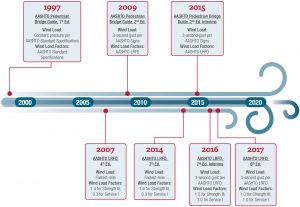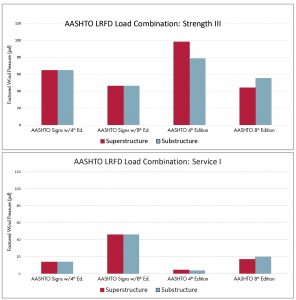Pedestrian and multi-use trail bridges have become more popular as public and private entities invest in alternative modes of transportation, human-scale design, and user safety. The design of these structures is typically adapted from vehicular bridge design methodology. While the scale of pedestrian bridges simplifies portions of the analysis, such as considering multiple lanes and certain load combinations, it adds several wrinkles, including vibration and increased attention to lateral loads. The American Association of State Highway and Transportation Officials (AASHTO) LRFD Guide Specifications for the Design of Pedestrian Bridges (AASHTO Pedestrian Bridge Guide) addresses these design aspects unique to pedestrian structures. Its use is strongly recommended by AASHTO’s Load and Resistance Factor Bridge Design Specifications (AASHTO LRFD) when designing pedestrian bridges and other structures not carrying full highway loading. In fact, a recent survey of state bridge offices found that over 90% of states explicitly require the use of the AASHTO Pedestrian Bridge Guide when designing such facilities in their jurisdiction. Despite a guide specification dedicated to pedestrian bridges, evaluating wind load on these structures involves consulting and cross-referencing various specifications based on different analysis methods. The indirect approach to wind loading makes it difficult for engineers to ensure appropriate design procedures are followed and fails to provide consistent reliability across the industry. This article reviews the evolution of wind load criteria, examines current wind load criteria for pedestrian bridges, and provides a path towards establishing a consistent design methodology for wind loading on pedestrian bridges.
Evolution of Wind Load Criteria
The approach to wind loading in the AASHTO Pedestrian Bridge Guide has evolved since it was first published in 1997. This first edition used a simplified approach consistent with the AASHTO Standard Specifications for Highway Bridges (AASHTO Standard Specifications). In place of correlating wind speeds to applied pressures or more refined analyses, a uniform wind pressure was used based on empirical methods. The 2nd (and latest) edition of the AASHTO Pedestrian Bridge Guide was published in 2009, with interim revisions issued in 2015 that do not impact the wind load criteria. This edition reflected the transition from Load Factor Design (LFD) in AASHTO Standard Specifications to Load and Resistance Factor Design in AASHTO LRFD and correlated wind speeds directly to wind pressures. However, instead of incorporating the wind load procedure in AASHTO LRFD, it requires that wind pressures be calculated using AASHTO Standard Specifications for Structural Supports for Highway Signs, Luminaires, and Traffic Signals (AASHTO Signs) using a mean recurrence interval (MRI) of 100 years. Per the AASHTO Pedestrian Bridge Guide, the wind pressures generated using AASHTO Signs are then factored using load combinations from AASHTO LRFD.
This approach to wind loading is due to the similarities between pedestrian bridges and overhead sign structures in the United States. Both structure types can span over roadways, frequently consist of steel truss elements, and are subject to relatively low gravity loads. Prefabricated steel trusses, which have the most in-common with overhead signs, are a popular solution for many owners seeking to provide pedestrian and bicycle access across roadways and other obstacles. This logic is also reflected in the commentary of the AASHTO Pedestrian Bridge Guide, which states:
The wind loading is taken from AASHTO Signs specification rather than from AASHTO LRFD due to the potentially flexible nature of pedestrian bridges and also due to the potential for traffic signs to be mounted to them.
When the current AASHTO Pedestrian Bridge Guide was published, AASHTO LRFD wind load provisions used the fastest-mile wind speed approach. The fastest-mile wind calculation was based on determining the shortest time a mile-long column of air would take to travel past a fixed point. A base wind speed of 100 miles per hour and a constant base wind pressure were used for structural calculations regardless of location. Alternatively, engineers could perform a site-specific wind study. The pressures generated from these wind speeds were then factored according to each load combination, as shown in the Table. This fastest-mile wind pressure calculation was considered reasonable for most of the United States but was unconservative in hurricane-prone regions and failed to provide uniform reliability to structural designs.

The 8th edition of AASHTO LRFD sought to provide uniform reliability across the country using a design wind speed that reflects the actual wind speed at a given location. The updated specifications adopted a constant averaging time of 3-seconds per gust, aligning with ASCE-7 Minimum Design Loads for Buildings and Other Structures (ASCE-7) and data from the National Weather Service. This edition and subsequent editions of AASHTO LRFD vary the wind speed based on geographic location and the load combination being applied, as summarized in the Table. Since wind speeds now vary among load combinations, all load factors for wind pressures were changed to 1.0. This is a significant departure from the previous wind loading criteria, and its ramifications have not been reflected in the AASHTO Pedestrian Bridge Guide.
Current Wind Load Criteria
Structural engineers must be aware of the updates to AASHTO LRFD since the publication of the AASHTO Pedestrian Bridge Guide or risk underestimating the wind pressures on the structure. The AASHTO Pedestrian Bridge Guide references AASHTO LRFD 4th Edition, but there is no language highlighting the importance of which AASHTO LRFD edition to incorporate. Furthermore, the references to AASHTO LRFD 4th Edition are not specific to the wind loading and are only found in the design example and the listed references at the end of the specification. As shown in Figure 1, AASHTO LRFD 4th Edition was published prior to overhauling wind load criteria in AASHTO LRFD 8th Edition.

The current AASHTO LRFD wind load criteria use an MRI of 700 years for vehicular bridge design, whereas AASHTO Signs uses 100 years. As shown in Figure 2, this discrepancy would have been addressed at the time of publication of AASHTO Signs by the AASHTO LRFD 4th Edition load factors. However, if the load factors in the current version of AASHTO LRFD are used in pedestrian bridge strength design, the wind pressures from AASHTO Signs would not be increased, and the structure would only be designed for an MRI of 100 years. This underestimates the wind load on the structure since the AASHTO Pedestrian Bridge Guide intended this load to be increased by 40%. While it may be acceptable to design some pedestrian bridges for a lower MRI than vehicular bridges, many of these structures span critical infrastructure networks or support commuter routes. Reduced reliability of a structure should be an intentional design decision in coordination with the Owner, not due to discrepancies in the design criteria. This creates a significant tension for engineers who should consult AASHTO LRFD 4th Edition for wind load factors and later AASHTO LRFD editions for everything else, inviting inconsistencies to designs and built structures. Figure 2 demonstrates the potential variability of wind loading based on the different design criteria.

Wind loads on fences and railings are another area of inconsistency in pedestrian bridge design. AASHTO LRFD stipulates that the design wind load for a chain-link or metal-fabric fence shall be 15 pounds per square foot applied to the full fence height. This clause from AASHTO LRFD is not in the AASHTO Pedestrian Bridge Guide nor AASHTO Signs. Calculating wind load on fences or railings using AASHTO Signs involves determining the obstructed area, estimating the drag coefficient of specific members, and measuring the distance between windward and leeward sides. Many engineers and truss manufacturers simplify this calculation by conservatively applying the superstructure wind pressure to the full projected area of the fence or railing while neglecting the leeward side. While this approach seems reasonable and conservative for most cases, specific guidance on how to accurately account for wind loads on fences and railings could promote more efficient and consistent structural designs. Fences and railings can constitute most of the superstructure height for pedestrian bridges. Therefore, conservative estimates of these loads may considerably impact the structure and cost.
It is imperative to use engineering judgment when applying wind load specifications to pedestrian bridges. While typical vehicular and highway bridges are rarely governed by wind loading, pedestrian bridges are much more likely to be governed by wind and other lateral loads. Therefore, the design and cost implications of applied wind pressures will significantly impact owners and end-users. The updated wind load criteria in AASHTO LRFD impact the applied wind pressure, which can dictate superstructure-to-substructure connections, bearing requirements, and substructure design. Piers and intermediate bents for pedestrian bridges can reach substantial heights to meet vertical clearance requirements over highways or provide users with scenic views. Small differences in lateral loads applied at the top of these tall column elements may dictate their size and govern their foundations. In particular, pile footings can be dramatically affected as many owners discourage or forbid pile uplift forces. Pedestrian bridges have relatively lower dead loads to counteract overturning, so uplift forces frequently control foundation sizes and pile embedment. A conservative approach to wind loading may result in sizable cost increases for the substructure and foundation, which are main factors in the overall cost. For some pedestrian bridge superstructures and substructures, AASHTO LRFD could be more appropriate than AASHTO Signs if these structural elements are less flexible and less sign-like, such as reinforced concrete slabs, composite steel girders, short span timber, or concrete columns.
Conclusion
The stated purpose of load and resistance factor design specifications is to build structures according to a precise statistical method and a specific level of reliability that values user safety. Today, pedestrian bridges can be designed and constructed to a wide range of reliabilities due to the cross-referencing of different specifications which use different analysis methods, without clarity on which edition should be applied. An update to the AASHTO Pedestrian Bridge Guide could include wind load criteria rather than referencing AASHTO Signs and provide more guidance on fence and railing loads. If using AASHTO Signs as a design supplement is preferable, the AASHTO Pedestrian Bridge Guide could provide additional commentary on when it is acceptable to reference AASHTO Signs based on the bridge type, natural frequency, or weight-to-width ratio. Alternatively, it could refer to a specific edition of AASHTO LRFD for wind load factors or explicitly provide LRFD load combinations.
In the meantime, the authors believe engineers should consider applying the load factors in AASHTO LRFD 4th Edition, rather than the reduced load factors in more recent editions, to align with the original intent of the AASHTO Pedestrian Bridge Guide. Regardless of updates to the wind loading criteria or the design approach, engineers must always rely on sound reasoning and communicate clearly with owners when establishing wind load criteria.■
